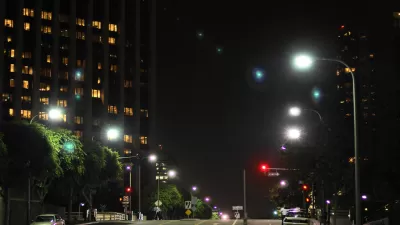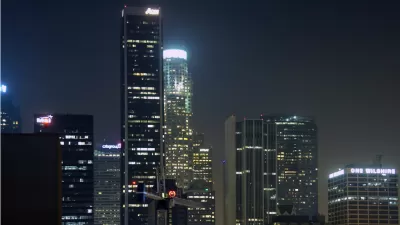Forbes Magazine reflects on the importance and impacts of light-emitting diode (LED) lights as more cities replace their traditional streetlamps with LEDs.
Los Angeles's Bureau of Street Lighting has been busy in the last five years, spending $57 million to replace 155,000 streetlamps with light-emitting diode (LED) lights. With 60,000 more to go, most of them being tricky decorative lights, the city will spend $50 million more. Los Angeles is at the forefront of an often overlooked and seldom discussed factor of urbanization, light pollution.
With more cities and businesses requiring light for commercial or safety purposes, the effects of lighting can lead to surges in electricity consumption, destruction of environment and wildlife, and elimination of the starry nights that have inspired humanity for thousands of years.
A recent article in Forbes Magazine by Ucilia Wang focuses on the importance and potential impacts of lighting cities with LEDs. In recent years, LEDs have proven to more cost effective than regular high-pressure streetlamps, as they "last three to four times longer and produce two to three times more light per watt, delivering anywhere from 30% to 70% in annual electricity savings...they’re also far more programmable and connect more efficiently with radio and sensor chips to create citywide wireless networks to monitor crime, power outages and water main breaks and coordinate disaster relief."
Wang also explains how LED streetlamps can use less light by connecting to motion sensors, and thus eliminating waste. On average, forty percent of any given city's electricity needs powers street lighting, and nearly fifty percent of that is wasted. Aiming to solve this problem, the Danis Outdoor Lighting Lab, or DOLL Lab, located outside of Copenhagen, is already pioneering motion-sensing LED streetlamp experiments in their living lab.
As previously covered in Planetizen, changing from traditional streetlamps to LED lights not only saves municipalities millions each year, but also benefits cinematography.
FULL STORY: How LEDs Are Going To Change The Way We Look At Cities

Alabama: Trump Terminates Settlements for Black Communities Harmed By Raw Sewage
Trump deemed the landmark civil rights agreement “illegal DEI and environmental justice policy.”

Study: Maui’s Plan to Convert Vacation Rentals to Long-Term Housing Could Cause Nearly $1 Billion Economic Loss
The plan would reduce visitor accommodation by 25% resulting in 1,900 jobs lost.

Planetizen Federal Action Tracker
A weekly monitor of how Trump’s orders and actions are impacting planners and planning in America.

Wind Energy on the Rise Despite Federal Policy Reversal
The Trump administration is revoking federal support for renewable energy, but demand for new projects continues unabated.

Passengers Flock to Caltrain After Electrification
The new electric trains are running faster and more reliably, leading to strong ridership growth on the Bay Area rail system.

Texas Churches Rally Behind ‘Yes in God’s Back Yard’ Legislation
Religious leaders want the state to reduce zoning regulations to streamline leasing church-owned land to housing developers.
Urban Design for Planners 1: Software Tools
This six-course series explores essential urban design concepts using open source software and equips planners with the tools they need to participate fully in the urban design process.
Planning for Universal Design
Learn the tools for implementing Universal Design in planning regulations.
Caltrans
Smith Gee Studio
Institute for Housing and Urban Development Studies (IHS)
City of Grandview
Harvard GSD Executive Education
Toledo-Lucas County Plan Commissions
Salt Lake City
NYU Wagner Graduate School of Public Service




























